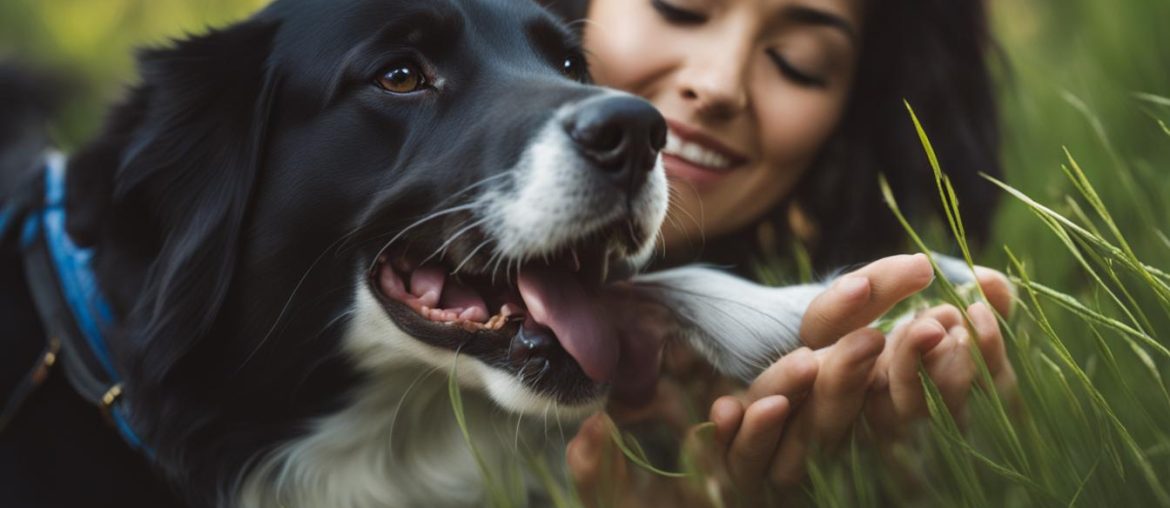Dogs licking their owners’ hands is a behavior that many pet owners have experienced. It can be a sweet and endearing gesture, but have you ever wondered why your dog does it? Understanding the reasons behind this behavior can help you better understand your furry friend and strengthen your bond. Let’s explore the various meanings behind dog licking behavior.
Key Takeaways:
- Dogs lick their owners’ hands to show affection and build a closer connection.
- Licking can also be a form of communication, as dogs use it to signal their needs and emotions.
- Some dogs lick as a self-soothing mechanism to calm themselves in stressful situations.
- Licking can be a way for dogs to explore scents and gather information about their environment.
- While dog licking is generally harmless, excessive licking may indicate underlying health issues or compulsive behaviors that require attention.
Affectionate Gesture
Dogs often lick their owners’ hands as a way to show affection. Licking is a common feature of dog body language and is seen as a display of love and closeness. Dogs may lick their owners’ hands to greet them, express happiness, or seek reassurance. It is a natural behavior for dogs to lick their loved ones as a sign of affection and connection.
When dogs lick their owners’ hands, it is their way of expressing love and bonding. This behavior is rooted in their instinctual desire to establish a strong emotional connection with their human companions. It is a gesture that demonstrates their affection and loyalty towards their owners.
The act of licking can also release endorphins in dogs, giving them a sense of pleasure and comfort. It is their way of showing that they feel safe, content, and happy in their owner’s presence.
Moreover, licking can also be a form of grooming for dogs. In the wild, pack members often engage in mutual grooming to strengthen social bonds. When a dog licks its owner’s hands, it is a similar behavior, symbolizing their role as a member of the family or pack.
Overall, when dogs lick their owners’ hands, it is a heartwarming display of love and affection. It is their unique way of showing that they care and value their human companionship.
Communication Signal
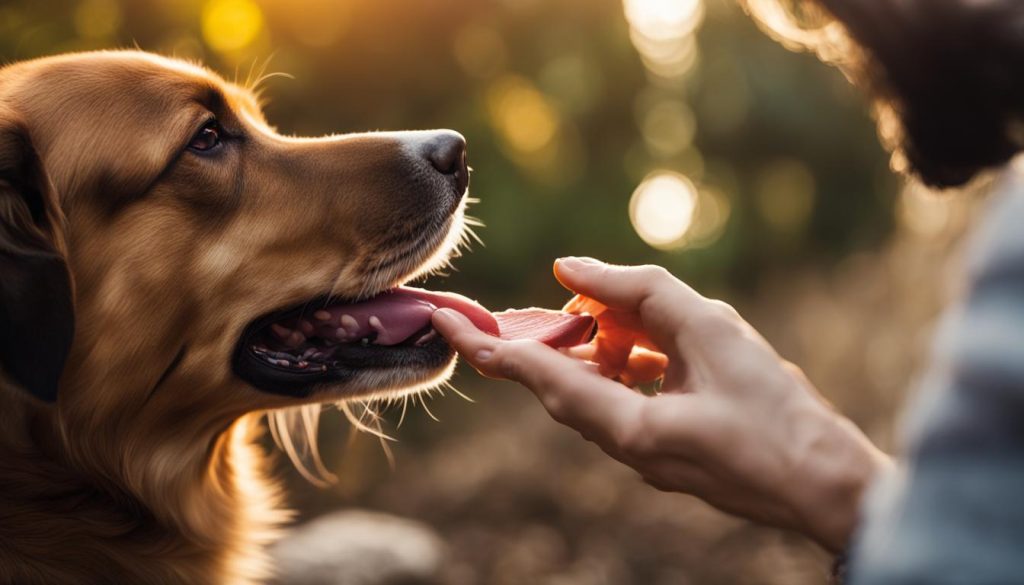
Dogs have a unique way of communicating with their owners, and licking is one of the ways they express themselves. When a dog licks their owner’s hands, it can convey various messages and emotions. Understanding the signs of dog affection through licking can help pet owners decipher their furry friend’s needs and desires.
One of the primary reasons dogs lick their owners’ hands is to seek attention. It’s their way of saying, “Hey, I want your love and affection right now!” Licking can also indicate a desire to go outside for a walk or bathroom break. It’s their gentle and subtle way of letting you know they need to relieve themselves.
“A dog’s lick can speak louder than words. It’s their way of communicating their needs and emotions,” says Dr. Emily Thompson, a canine behavior expert.
Additionally, dogs may lick their owners’ hands as a way to grab their attention. Just like humans tap someone on the shoulder to get their focus, dogs use licking as a communication tactic. By licking your hands, they’re trying to say, “Look at me, I have something important to tell you!” So, pay close attention to their body language and understand the meaning behind their licking behavior.
Calming Mechanism

One fascinating reason why dogs lick their owners’ hands is as a calming mechanism. Licking can actually help dogs calm themselves in stressful or anxious situations. This repetitive behavior releases endorphins in dogs, which can make them feel better and reduce their stress levels.
When a dog licks their owner’s hand, it is a self-soothing mechanism that helps them cope with anxiety or uncertainty. The rhythmic action of licking provides comfort and creates a sense of security for dogs. It is similar to how humans may use repetitive actions or behaviors during times of stress or nervousness.
However, it’s important to note that excessive licking can be a sign of underlying anxiety or discomfort in dogs. If a dog is continuously licking their owner’s hand or engaging in obsessive licking behaviors, it may indicate a deeper issue that needs to be addressed. It is essential to observe the frequency and intensity of the licking behavior and consult with a veterinarian if necessary.
Understanding the calming mechanism behind dog licking can help pet owners provide a supportive environment for their furry friends. By recognizing when a dog may be using this behavior as a coping mechanism, owners can take steps to alleviate their pet’s anxiety and provide alternative methods for relaxation.
| Benefits of dog licking as a calming mechanism: |
|---|
| Dogs can self-soothe and reduce stress |
| Creates a sense of security and comfort |
| Provides a natural coping mechanism |
Comforting Gesture
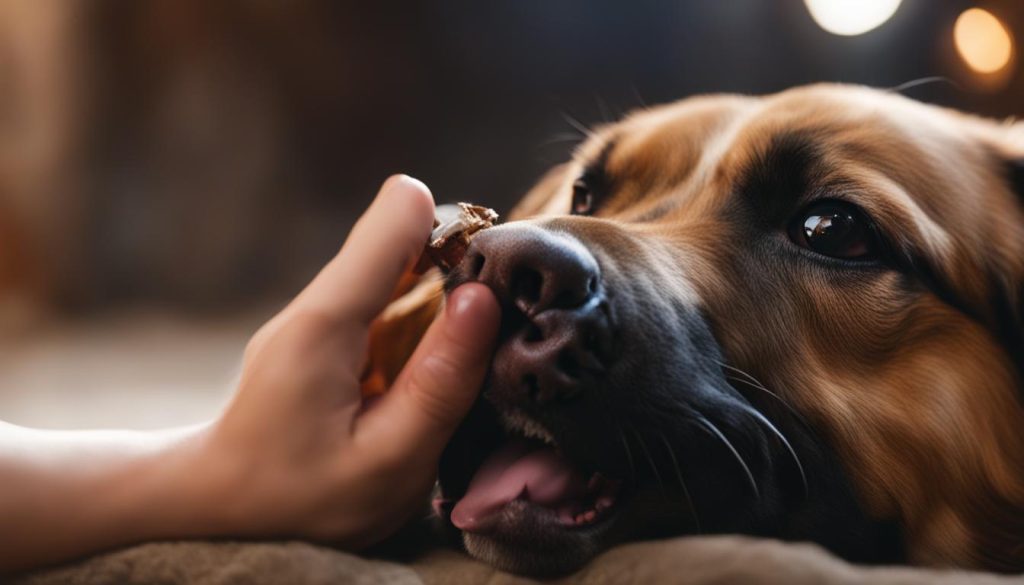
Dogs have an incredible ability to sense our emotions and offer comfort in times of distress. When their owners are upset or crying, dogs often demonstrate their empathy by licking their hands. This gesture is a natural instinct for dogs to try to provide solace and make their owners feel better.
Through licking, dogs show their caretakers that they are there to support them emotionally. The act of licking can release endorphins in dogs, which helps them feel better and reduces stress levels. The comforting gesture of licking is an expression of empathy and care from our furry companions.
This behavior can be particularly comforting for individuals experiencing anxiety, sadness, or stress. The gentle touch and soothing sensation of a dog’s licking can be a calming presence during difficult moments.
Image:
Quotes:
“My dog always comes to me and licks my hands when I’m feeling down. It’s as if he knows exactly what I need.” – Sarah, dog owner
Data:
| Survey Results: Dogs Licking as a Comforting Gesture |
|---|
| Percentage of dog owners who reported their dogs licking their hands during times of distress or sadness |
| 75% |
| Percentage of dog owners who found their dogs’ licking behavior comforting |
| 90% |
Curiosity and Exploration
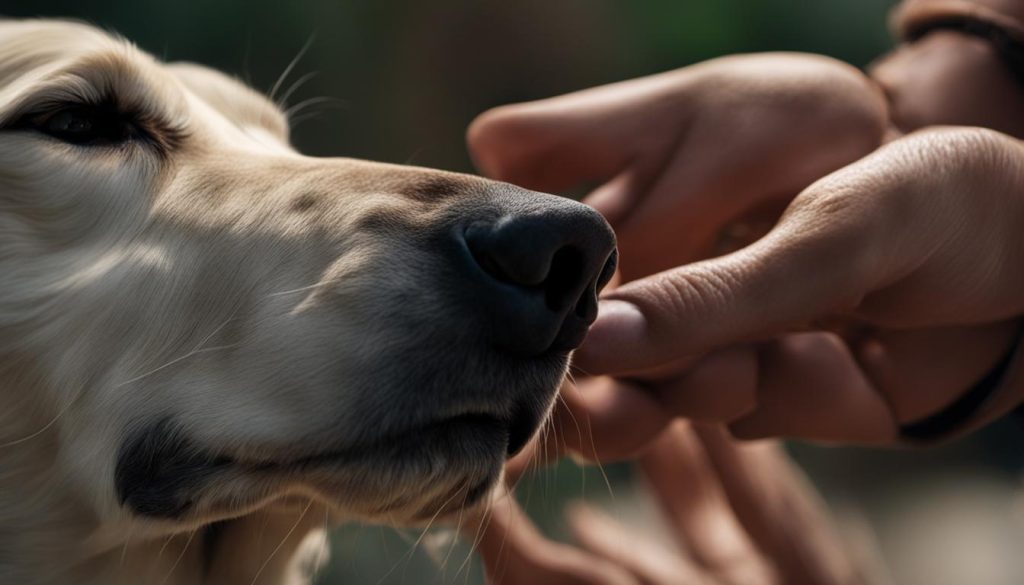
Dogs are naturally curious animals and use their senses to explore the world around them. Licking their owners’ hands can be a way for dogs to gather information about their environment and the scents present on their owners’ hands. Dogs have a highly developed sense of smell, and by licking their owners’ hands, they can detect different scents and investigate the smells they find interesting. It is a canine instinct to investigate and explore through licking.
Hygiene and Cleaning Behavior
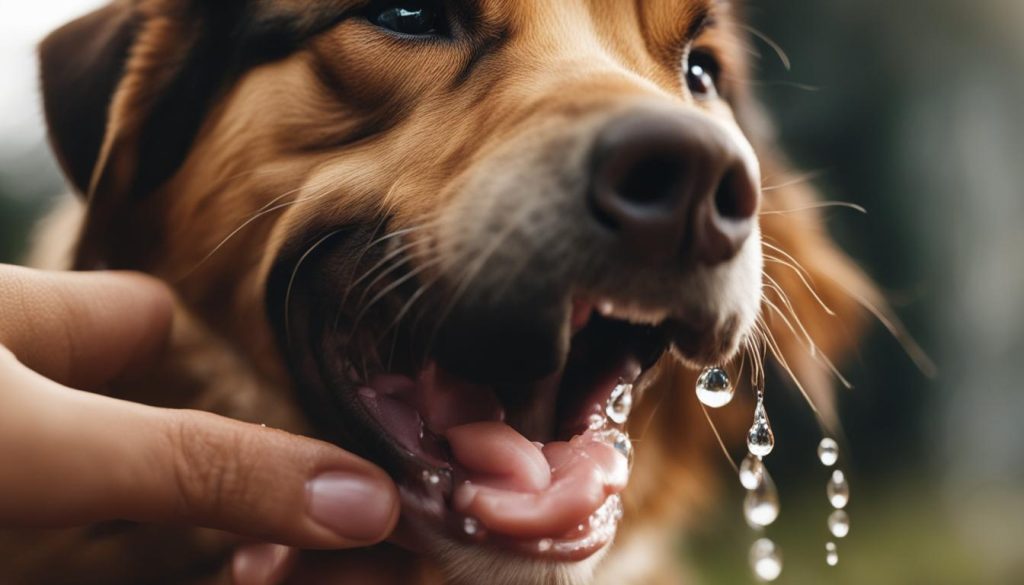
Dogs have a natural inclination to clean themselves and their surroundings. Licking is a self-grooming behavior for dogs, and they may lick their owners’ hands as a way to keep them clean. This behavior serves as a form of personal hygiene for dogs.
Dogs are fastidious creatures and use their tongues to remove dirt, debris, and potentially harmful substances from their fur. When they lick their owners’ hands, they are extending their grooming behavior to ensure the cleanliness of their human companions as well. Whether it’s a quick lick or a thorough wash, dogs view this cleaning behavior as a way to maintain a hygienic environment.
Not only do dogs lick their owners’ hands to clean them, but they may also be attracted to any food residue or scents left on the hands. The scent of food can be particularly appealing to dogs, and they might lick their owners’ hands in an attempt to savor any remaining taste. This behavior is instinctual for dogs, as they are natural scavengers and opportunistic eaters.
While some owners may find the idea of their dog licking their hands unhygienic, it’s important to note that a dog’s mouth contains certain enzymes and compounds that help fight bacteria. However, it’s always advisable to wash hands thoroughly after interacting with dogs. This can minimize any potential risks associated with bacteria or allergens that may be present in a dog’s saliva.
| Pros of Dog Licking as a Cleaning Behavior | Cons of Dog Licking as a Cleaning Behavior |
|---|---|
|
|
Training Tips to Stop Licking

If you find that your dog’s licking behavior has become problematic or unwanted, there are several effective training techniques that can help discourage this behavior. The key is to identify the root cause of the licking, whether it is related to stress, anxiety, attention-seeking, or simply a habit. Once you understand the underlying reason, you can apply positive reinforcement training to redirect your dog’s behavior toward more desirable actions.
Here are some training tips to help you stop your dog from licking your hands:
- Identify the cause: Pay attention to when and why your dog licks your hands. Is it when they are excited, anxious, or seeking attention? Understanding the cause will help you tailor your training approach.
- Positive reinforcement: Reward your dog for not licking your hands. Use treats, praise, and affection to reinforce alternative behaviors, such as sitting or going to their bed.
- Provide alternatives: Give your dog appropriate outlets for licking, such as chew toys or lick mats. Redirect their licking behavior towards these items to satisfy their instinct without involving your hands.
- Teach alternative cues: Train your dog to respond to alternative cues instead of licking. For example, teach them to give you a “paw” or “high five” when they want attention instead of licking your hands.
Consistency is key when training your dog to stop licking. Make sure everyone in the household is on the same page and enforces the training techniques consistently. With time and patience, you can successfully train your dog to refrain from licking your hands.
Is It Hygienic to Let Dogs Lick Hands?
While some people may not have an issue with their dog licking their hands, there are hygiene concerns associated with dog saliva. Dog saliva contains bacteria, and while most of them are not harmful to humans, there is a risk of transmitting certain infections or diseases through dog saliva, especially if the dog has consumed raw meat or has a compromised immune system. It is important for pet owners to weigh the benefits and risks before allowing their dogs to lick their hands.
It’s important to be aware that dog saliva can contain bacteria that may be harmful if transmitted to humans. While dogs lick themselves as part of their grooming routine, there is a possibility that their saliva may carry bacteria, such as Campylobacter or Salmonella. These bacteria are typically harmless to dogs but can cause gastrointestinal illnesses in humans.
In addition to bacteria, dog saliva may also contain traces of allergens, pathogens, or parasites. If a dog has been in contact with certain substances or has recently consumed raw meat or unclean water, these contaminants may be present in their saliva.
It is important to note that the risk of infection or illness from dog saliva is relatively low under normal circumstances. However, individuals with compromised immune systems, young children, or people with open wounds are more susceptible to potential risks.
Hygiene Tips for Dog Owners
- Wash your hands regularly: After interacting with your dog, it’s essential to wash your hands thoroughly with soap and water to minimize the risk of bacterial transmission.
- Keep your dog clean: Regular grooming and bathing can help reduce the bacteria present in your dog’s saliva. Use pet-friendly products and consult your veterinarian for guidance on appropriate grooming practices.
- Avoid face licking: While it may be tempting to let your dog lick your face, it’s best to avoid this practice to minimize the risk of bacterial transfer to sensitive areas.
- Train your dog: Teaching your dog appropriate behaviors, such as not licking or only licking on command, can help maintain good hygiene practices.
By taking these precautions, pet owners can strike a balance between enjoying the bond with their dogs and maintaining good hygiene standards.
| Hygiene Concerns of Dog Licking | Risks of Dog Saliva |
|---|---|
| – Possible transmission of bacteria – Presence of allergens, pathogens, and parasites in saliva – Increased risk for individuals with compromised immune systems or open wounds |
– Gastrointestinal illnesses (e.g., Campylobacter, Salmonella) – Infections or allergies related to bacteria or contaminants in saliva |
While it’s generally safe to allow dogs to lick hands, it’s important to consider the hygiene concerns associated with dog saliva. By understanding the risks and implementing proper hygiene practices, pet owners can enjoy the affectionate gesture of dog licking while minimizing potential health concerns.
Excessive Licking and Compulsive Behaviors
Excessive licking in dogs can be indicative of underlying health issues or compulsive behaviors. Dogs that excessively lick their bodies or objects may be at risk of developing potential health problems and compulsive behaviors. It is crucial for pet owners to closely monitor their dog’s licking behavior and seek professional veterinary advice if it becomes excessive or compulsive. Identifying and addressing the root cause is key to effectively managing and treating excessive licking.
Signs of Excessive Dog Licking
Excessive dog licking can manifest in various ways. Some common signs to watch for include:
- Constant licking of paws, legs, or other body parts
- Repeated licking of floors, walls, or objects
- Intense focus on specific areas, leading to hair loss or skin irritation
- Compulsive licking even when there are no external stimuli
If you notice any of these behaviors in your dog, it is important to consult with a veterinarian to determine the underlying cause.
Potential Health Issues Associated with Excessive Licking
Excessive licking can lead to various health issues, including:
| Health Issue | Description |
|---|---|
| Skin Irritation and Infections | Excessive licking can damage the skin, causing irritation and creating an entry point for infections. |
| Hot Spots | Excessive licking can result in the development of hot spots, which are painful, inflamed areas on the skin. |
| Digestive Problems | If a dog ingests excessive amounts of fur or other substances while licking, it can lead to digestive issues or blockages. |
| Behavioral Issues | Compulsive licking can indicate underlying anxiety or stress, which may require behavioral intervention. |
Understanding the potential health risks associated with excessive licking emphasizes the importance of addressing this behavior promptly.
Addressing Excessive Licking
To address excessive licking in dogs, pet owners should:
- Consult with a veterinarian to rule out any underlying health conditions or allergies.
- Implement environmental enrichment strategies to reduce anxiety and boredom.
- Provide appropriate chew toys or interactive puzzles to redirect licking behavior.
- Utilize positive reinforcement training techniques to discourage excessive licking and reward alternative behaviors.
Remember, in cases of compulsive licking or severe health issues, it is always best to consult with a qualified veterinarian for guidance and support.
Setting Boundaries and Training Consistency
If you prefer not to allow your dog to lick your hands, it is important to set clear boundaries and be consistent in enforcing them. Dogs are highly trainable and with patience and consistency, you can redirect their behavior and teach them alternative greetings. By providing them with clear commands and reinforcing positive actions, you can effectively manage and control their licking behavior.
Teaching Alternative Greetings
To redirect your dog’s behavior away from licking, you can teach them alternative greetings such as the “touch” command. This involves training your dog to touch their nose to the back of your hand or another designated target as a friendly greeting. By substituting licking with this alternative behavior, you can maintain a bond with your dog while setting limits on excessive licking.
Training Consistency
Consistency is key when training your dog to stop licking. Make sure everyone in the household follows the same rules and reinforces the same boundaries. It is important not to allow licking in some situations while prohibiting it in others, as this can confuse your dog and undermine the training process. Consistency in training methods and expectations will help your dog understand what is acceptable behavior.
Remember, training takes time and patience. Reinforce positive behavior with rewards and praise, and redirect undesired behavior calmly and gently. Consistency is the key to success in setting boundaries for dog licking.
| Benefits of Setting Boundaries | Tips for Training Consistency |
|---|---|
| 1. Prevents the spread of bacteria and potential infections | 1. Clearly communicate expectations to all family members. |
| 2. Maintains good hygiene and cleanliness | 2. Use positive reinforcement to reward desired behavior. |
| 3. Ensures comfort and personal boundaries | 3. Redirect undesired licking behavior to alternative greetings or commands. |
| 4. Promotes respectful interactions with guests | 4. Avoid situations that trigger excessive licking, such as prolonged petting sessions. |
Wrapping Up
In conclusion, understanding why dogs lick their owners’ hands is crucial for fostering a strong bond and effective communication in the dog-human relationship. This common behavior can have multiple meanings, including affection, communication, exploration, and self-comforting. By recognizing the underlying motives behind their dog’s licking behavior, pet owners can respond appropriately and provide the necessary care and attention.
It is important to consider personal preferences when it comes to allowing dogs to lick hands. While it can be a sign of love and closeness, some individuals may have hygiene concerns or find excessive licking undesirable. Setting clear boundaries and consistent training can help redirect a dog’s behavior and teach alternative greetings.
Furthermore, pet owners should be aware of the potential risks associated with dog saliva, especially for individuals with compromised immune systems or when dogs have ingested raw meat. If a dog’s licking behavior becomes excessive or compulsive, it is imperative to consult a veterinarian to rule out underlying health issues and address any arising concerns.
In conclusion, by understanding the reasons behind dog licking behavior and employing appropriate training techniques, pet owners can foster a harmonious relationship with their dogs, ensuring a better understanding of their needs and emotions.
FAQ
Why does my dog lick my hand?
Dogs may lick their owners’ hands as a sign of affection, communication, exploring scents, self-comforting, or cleaning behavior.
Is dog licking a form of affection?
Yes, dogs often lick their owners’ hands to show affection and to strengthen their bond.
How is dog licking a communication signal?
By licking their owners’ hands, dogs can convey their needs, seek attention, or communicate their emotions.
Why do dogs lick their owners’ hands as a calming mechanism?
Licking releases endorphins in dogs, which can help them feel better and reduce stress levels.
Why do dogs lick their owners’ hands as a comforting gesture?
When their owners are upset or crying, dogs may lick their hands to offer solace and provide comfort.
Why do dogs lick their owners’ hands out of curiosity and exploration?
Dogs use their sense of smell to explore the world, and licking their owners’ hands allows them to gather information about their environment and detect interesting scents.
Is dog licking a cleaning behavior?
Yes, dogs may lick their owners’ hands to keep them clean or to clean up food residue or scents they find appealing.
How can I stop my dog from licking my hands?
Training techniques, such as redirecting their behavior, providing alternative outlets for licking, and teaching alternative cues, can help discourage dogs from licking hands.
Is it hygienic to let dogs lick hands?
While most bacteria in dog saliva are not harmful to humans, there is a risk of transmitting infections or diseases through dog saliva, especially in certain circumstances.
What should I do if my dog excessively licks?
Excessive licking can be a sign of underlying health issues or compulsive behaviors, so it is important to monitor their behavior and consult with a veterinarian if necessary.
How can I set boundaries and enforce consistent training for licking?
Consistency in training, using commands like “off,” and teaching alternative greetings can help establish boundaries and control a dog’s licking behavior.
What is the significance of dog licking behavior in the dog-human interaction?
Understanding why dogs lick their owners’ hands can strengthen the bond between dogs and their owners and help interpret their needs and emotions effectively.


